Last updated 5/25/05 check back more updates coming soon!!!!!!!
Greetings fellow jeepers,
Wagoneerlover is at it again this time with a write up on D.I.Y TBI (Throttle body injection). I am not an authority on this subject and I don't claim to be. I simply attempt to help my fellow jeepers out there to work on and upgrade their rigs in the same fashion that I wanted to. I do write ups only on things that I have attempted, and succeeded at, that way i can at least get you from point a to completion. There are many on this board and on other boards etc, who are much more knowledgeable in this area than I am. So if I miss something or omit some info please let me know and I will add it immediately. (Of course this is within reason, I try not to add any info that I cannot verify myself, only because I don't want to give misleading information or post anything that I cannot actually answer questions on or verify. This article was written for those of you running V-8 AMC engines in your rigs, the buick and some of the other V-8 engines that were produced before my time that I have never seen would be similar in the adaptation areas, you would just need to figure out a few things. For those of you with the inline six engines, you may want to consider the chrycho multiport conversions before settling on a TBI setup. While the inline six can be adapted to TBI in a similar fashion to the 8, there are multiport setups and many have taken heads, intakes etc from the chrycho 242 engines (4.0 engine) and adapted it to the 258 thus creating a multiport setup. I must say that setting up and installing this TBI has been a great experience. Many argue that a well tuned carb will perform just as well as the TBI and that doing such a mod is almost useless blah blah blah (This may be true and for the ten people born in 1870 who are still alive who can super tune carbs then I guess that would be a valid point). For those of you are interested in such a swap there are several things that you want to consider before spending the money, effort and time to engage in such a modification. I agree that there are distinct pros and cons to installing TBI vs keeping a carburetor. Before I delve into the modification I will discuss some of the factors that you should consider before deciding to install Throttle body injection or simply keep your existing carb or upgrade to a better carb. If performance is your forte, then you should be aware of the fact that there are upgrades for TBI injection systems. Many will make the case that a 4bbl carb will outperform a 2bbl Throttle body any day. I agree that is true (At least in terms of horsepower gains) but for those of you willing to spend the cash they actually have 4bbl Throttle body systems. There will be four injectors mounted in the throttle body as opposed to two. Now how is that for performance? Secondly these injectors can be upgraded. Another performance option that I have taken note of is dual Throttle Body setups. These systems work in the same fashion as the hot rods that I have seen with dual carbs, only difference being that they have dual Throttle bodies. In the past such systems always had control issues when the computer tried to operate them, however there are now controllers which can handle them both effectively. I will not delve into the ramifications necessary for such mods, you will need to research them on your own. I will however detail as much as possible the methods necessary to adapt your rig to a stock 2bbl throttle body system. Before you attempt this modification there are many things which you will want to ask yourself and answer before going forward. First, how much of the project do you want to actually do yourself? This write up is written under the assumption that you will attempt to do most of the work yourself with little to no outside help. In this regard you will want to have distinct answers to the following questions once you have determined that you will go forward. How much of the work do I want to do myself? Should I simply purchase a kit and have some of the legwork taken out for me? Do I really want to spend the time pulling parts and gathering the things I need and installing them all and setting it up. Do I want to completely do this alone or will I do most of the work and get a third party to burn the chip for me (Sort of doing part of the work and having someone else do another part)? Before making your final decisions weigh your options and look at what is available out there on the market. There are pros and cons to complete systems, partial sytems custom systems and doing your own install (D.I.Y = do it yourself). I will not make arguments against the existing kits which are out there, nor will I badmouth any of the other developers out there. You should however be careul when being lulled into the claims of specialized chips made just for you and or other notions that might lead you into a hasty decision. Remember finally that when doing it yourself, you will learn the ins and outs of the system, you will have all GM parts for your fuel system which are easily and readily available on the shelf, and you will be able to tune, upgrade, repair and work on your system yourself at the completion of the D.I.Y install.
Additionally you will want to also consider the following things and reasons to simply leave the swap alone or go forward.
Reasons not to adapt to TBI
1. If you feel that you will magically go from the traditional 8-12 mpg associated with our rigs to 25 mpg then you are going to be disappointed and you will have wasted your time. Granted you can see gains of 2 or more mpg depending on how well you can tune your TBI but it is within limitations. If you truly want to get extremely high gas mileage numbers then you need to consider a diesel engine swap or an alternative fuel efficient vehicle.
2. If you think that by adapting to TBI you will somehow magically repair a tired, old and worn down engine then you are gravely mistaken. Do not adapt any worn down engine to fuel injection. It just is not a good practice. You may see some limited amount of pep re-injected into your engine but I can assure you that your engine will still meet the same end. (Meaning the piston knock, head leaks etc that were plaguing it before might possibly sort of have a temporary band aid on them but eventually the same thing will happen and you will have wasted money investing in fuel injection and you will need an additional wad of cash to get the engine back into running shape, thus wasting time and costing you tons of cash.) An engine with TBI on it that is locked up and not running is not cool!
3. If you plan on selling your rig in the immediate future or are unsure of how long you intend to keep it. (While it may seem like a great idea, often at times custom mods etc do not net the same value in return when being sold. (Sometimes they do but don’t count on it)
4. If you have no patience and you need things done the second you install them. Trust me TBI may run extremely well but there will be a period of adapting things to your engine, wiring and tuning headaches. Once you have it all set up it will all be worth it.
5. Do you want to actually spend the money to adapt to TBI? While it is not necessarily and extremely expensive mod, you can find the costs associated with this project beginning to skyrocket. This is especially true if you intend on getting performance out of your TBI with upgraded injectors or other mods.
6. Any other reason you can think of that might deter you from wanting to spend time, effort and money in such a project. If you just don’t feel like doing all the work, have a tight schedule with work and kids and cannot find enough time to even drink a soda, or you have a nagging wife or husband who is keeping accurate tabs on the checkbook and giving you that evil eye when such expenses are mentioned.
Some reasons to consider injecting your engine
1.You seek to gain improvements in off-road capability. (This capability will be seen in the steep angle sectors etc. The TBI and other forms of injection will keep running and pumping even at weird and strange angles, often at angles where a carb would shut off.
2. You enjoy improved reliability in the area of starting. Walk outside on a cold morning and I can assure you that if you set up your TBI properly that cold weather will not affect its firing up.
3.You seek great idle quality which may not be attainable by a carb (Note I say may not. I actually am not able to tune carbs so well but my grandfather could tune them like nobodies business. Unfortunately this art was lost just like the jedi arts in star wars!!)
4. You seek a system which will adjust itself for altitude compensation and other areas which it may need to compensate in. No more getting out and adjusting your rig for above and below sea level conditions or for changes in weather and environment the TBI will do that by itself through the usage of sensors and computer control.
5. You have run out of things to do to your rig, you don't want to swap in a more modern engine as of yet because your 401 or 360 runs fine and you simply are being true to form! (You cannot help but spending money on your rig and you need something to validate your urge to do just one more thing to it!)
Greetings fellow jeepers,
Wagoneerlover is at it again this time with a write up on D.I.Y TBI (Throttle body injection). I am not an authority on this subject and I don't claim to be. I simply attempt to help my fellow jeepers out there to work on and upgrade their rigs in the same fashion that I wanted to. I do write ups only on things that I have attempted, and succeeded at, that way i can at least get you from point a to completion. There are many on this board and on other boards etc, who are much more knowledgeable in this area than I am. So if I miss something or omit some info please let me know and I will add it immediately. (Of course this is within reason, I try not to add any info that I cannot verify myself, only because I don't want to give misleading information or post anything that I cannot actually answer questions on or verify. This article was written for those of you running V-8 AMC engines in your rigs, the buick and some of the other V-8 engines that were produced before my time that I have never seen would be similar in the adaptation areas, you would just need to figure out a few things. For those of you with the inline six engines, you may want to consider the chrycho multiport conversions before settling on a TBI setup. While the inline six can be adapted to TBI in a similar fashion to the 8, there are multiport setups and many have taken heads, intakes etc from the chrycho 242 engines (4.0 engine) and adapted it to the 258 thus creating a multiport setup. I must say that setting up and installing this TBI has been a great experience. Many argue that a well tuned carb will perform just as well as the TBI and that doing such a mod is almost useless blah blah blah (This may be true and for the ten people born in 1870 who are still alive who can super tune carbs then I guess that would be a valid point). For those of you are interested in such a swap there are several things that you want to consider before spending the money, effort and time to engage in such a modification. I agree that there are distinct pros and cons to installing TBI vs keeping a carburetor. Before I delve into the modification I will discuss some of the factors that you should consider before deciding to install Throttle body injection or simply keep your existing carb or upgrade to a better carb. If performance is your forte, then you should be aware of the fact that there are upgrades for TBI injection systems. Many will make the case that a 4bbl carb will outperform a 2bbl Throttle body any day. I agree that is true (At least in terms of horsepower gains) but for those of you willing to spend the cash they actually have 4bbl Throttle body systems. There will be four injectors mounted in the throttle body as opposed to two. Now how is that for performance? Secondly these injectors can be upgraded. Another performance option that I have taken note of is dual Throttle Body setups. These systems work in the same fashion as the hot rods that I have seen with dual carbs, only difference being that they have dual Throttle bodies. In the past such systems always had control issues when the computer tried to operate them, however there are now controllers which can handle them both effectively. I will not delve into the ramifications necessary for such mods, you will need to research them on your own. I will however detail as much as possible the methods necessary to adapt your rig to a stock 2bbl throttle body system. Before you attempt this modification there are many things which you will want to ask yourself and answer before going forward. First, how much of the project do you want to actually do yourself? This write up is written under the assumption that you will attempt to do most of the work yourself with little to no outside help. In this regard you will want to have distinct answers to the following questions once you have determined that you will go forward. How much of the work do I want to do myself? Should I simply purchase a kit and have some of the legwork taken out for me? Do I really want to spend the time pulling parts and gathering the things I need and installing them all and setting it up. Do I want to completely do this alone or will I do most of the work and get a third party to burn the chip for me (Sort of doing part of the work and having someone else do another part)? Before making your final decisions weigh your options and look at what is available out there on the market. There are pros and cons to complete systems, partial sytems custom systems and doing your own install (D.I.Y = do it yourself). I will not make arguments against the existing kits which are out there, nor will I badmouth any of the other developers out there. You should however be careul when being lulled into the claims of specialized chips made just for you and or other notions that might lead you into a hasty decision. Remember finally that when doing it yourself, you will learn the ins and outs of the system, you will have all GM parts for your fuel system which are easily and readily available on the shelf, and you will be able to tune, upgrade, repair and work on your system yourself at the completion of the D.I.Y install.
Additionally you will want to also consider the following things and reasons to simply leave the swap alone or go forward.
Reasons not to adapt to TBI
1. If you feel that you will magically go from the traditional 8-12 mpg associated with our rigs to 25 mpg then you are going to be disappointed and you will have wasted your time. Granted you can see gains of 2 or more mpg depending on how well you can tune your TBI but it is within limitations. If you truly want to get extremely high gas mileage numbers then you need to consider a diesel engine swap or an alternative fuel efficient vehicle.
2. If you think that by adapting to TBI you will somehow magically repair a tired, old and worn down engine then you are gravely mistaken. Do not adapt any worn down engine to fuel injection. It just is not a good practice. You may see some limited amount of pep re-injected into your engine but I can assure you that your engine will still meet the same end. (Meaning the piston knock, head leaks etc that were plaguing it before might possibly sort of have a temporary band aid on them but eventually the same thing will happen and you will have wasted money investing in fuel injection and you will need an additional wad of cash to get the engine back into running shape, thus wasting time and costing you tons of cash.) An engine with TBI on it that is locked up and not running is not cool!
3. If you plan on selling your rig in the immediate future or are unsure of how long you intend to keep it. (While it may seem like a great idea, often at times custom mods etc do not net the same value in return when being sold. (Sometimes they do but don’t count on it)
4. If you have no patience and you need things done the second you install them. Trust me TBI may run extremely well but there will be a period of adapting things to your engine, wiring and tuning headaches. Once you have it all set up it will all be worth it.
5. Do you want to actually spend the money to adapt to TBI? While it is not necessarily and extremely expensive mod, you can find the costs associated with this project beginning to skyrocket. This is especially true if you intend on getting performance out of your TBI with upgraded injectors or other mods.
6. Any other reason you can think of that might deter you from wanting to spend time, effort and money in such a project. If you just don’t feel like doing all the work, have a tight schedule with work and kids and cannot find enough time to even drink a soda, or you have a nagging wife or husband who is keeping accurate tabs on the checkbook and giving you that evil eye when such expenses are mentioned.
Some reasons to consider injecting your engine
1.You seek to gain improvements in off-road capability. (This capability will be seen in the steep angle sectors etc. The TBI and other forms of injection will keep running and pumping even at weird and strange angles, often at angles where a carb would shut off.
2. You enjoy improved reliability in the area of starting. Walk outside on a cold morning and I can assure you that if you set up your TBI properly that cold weather will not affect its firing up.
3.You seek great idle quality which may not be attainable by a carb (Note I say may not. I actually am not able to tune carbs so well but my grandfather could tune them like nobodies business. Unfortunately this art was lost just like the jedi arts in star wars!!)
4. You seek a system which will adjust itself for altitude compensation and other areas which it may need to compensate in. No more getting out and adjusting your rig for above and below sea level conditions or for changes in weather and environment the TBI will do that by itself through the usage of sensors and computer control.
5. You have run out of things to do to your rig, you don't want to swap in a more modern engine as of yet because your 401 or 360 runs fine and you simply are being true to form! (You cannot help but spending money on your rig and you need something to validate your urge to do just one more thing to it!)

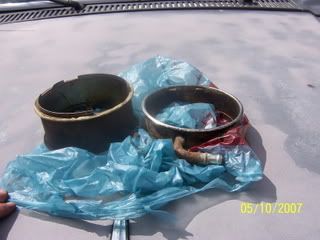
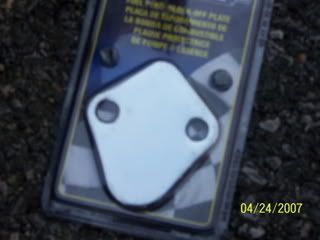
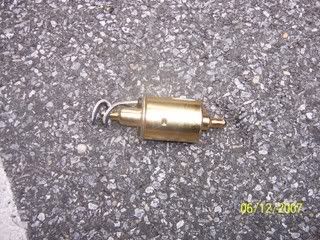
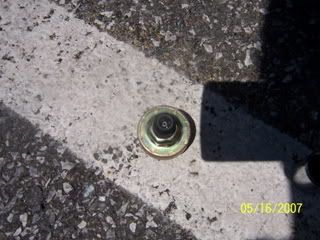

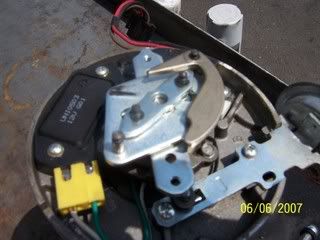 Once the weights are removed you will notice the mechanical advance arms. These arms will move freely back and fourth with the weights removed. (This is a bad thing for the fuel injected rig) The computer will control the advance so these arms need to be locked in place. You may use lockwire as I did, you can weld them in place, you can drill them and put screws through them or whatever method you choose as long as they dont move. Make sure that before you lock them in place you position them in a way that the rotor can be re-installed once finished. The first time I locked them in place I locked them in the fully closed position. The rotor screw holes did not align with the mechanical advance arm holes in this position!! (You need to be able to re-install the rotor!!). Once the arms have been locked in place you can turn your attention to the vacuum advance module. You have two options here, you can either leave the vacuum advance unit in place and simply remove the vacuum hose running to it which will disable it. The other option is to remove the vacuum advance module and to place a screw through the reluctor ring pin. (The vacuum advance module holds the reluctor ring in place and advances it etc yet if you remove the vacuum module you need another way to hold it still. Dont worry again the computer controls this now!) Once you have decided you may now turn your attention to the control module. The control module for the HEI is toward the rear of the case. It should have four pins with wires connected to each pin. Don't cut or splice these wires just yet, you will be re-using them on the 7 or 8 pin module later. If you have purchased the 7 pin module that is great as you can re-install it back in the case where the old 4 pin went. (It will fit with slight mods) Remove the connectors that are attached to the 4 pin HEI module. You may need to remove the module first. The module is held in place by two phillips head screws. simply remove them and unplug the connectors and remove the module. if you notice there is thermal grease all over where the old module used to be. Clean this up and get ready to install your new 7 pin module. Test fit the module a few times. It has tabs in the front and also two screw holes. The tabs in the front will fit in the stock position yet the screw holes will not align. You will need to drill new holes in the case.
Once the weights are removed you will notice the mechanical advance arms. These arms will move freely back and fourth with the weights removed. (This is a bad thing for the fuel injected rig) The computer will control the advance so these arms need to be locked in place. You may use lockwire as I did, you can weld them in place, you can drill them and put screws through them or whatever method you choose as long as they dont move. Make sure that before you lock them in place you position them in a way that the rotor can be re-installed once finished. The first time I locked them in place I locked them in the fully closed position. The rotor screw holes did not align with the mechanical advance arm holes in this position!! (You need to be able to re-install the rotor!!). Once the arms have been locked in place you can turn your attention to the vacuum advance module. You have two options here, you can either leave the vacuum advance unit in place and simply remove the vacuum hose running to it which will disable it. The other option is to remove the vacuum advance module and to place a screw through the reluctor ring pin. (The vacuum advance module holds the reluctor ring in place and advances it etc yet if you remove the vacuum module you need another way to hold it still. Dont worry again the computer controls this now!) Once you have decided you may now turn your attention to the control module. The control module for the HEI is toward the rear of the case. It should have four pins with wires connected to each pin. Don't cut or splice these wires just yet, you will be re-using them on the 7 or 8 pin module later. If you have purchased the 7 pin module that is great as you can re-install it back in the case where the old 4 pin went. (It will fit with slight mods) Remove the connectors that are attached to the 4 pin HEI module. You may need to remove the module first. The module is held in place by two phillips head screws. simply remove them and unplug the connectors and remove the module. if you notice there is thermal grease all over where the old module used to be. Clean this up and get ready to install your new 7 pin module. Test fit the module a few times. It has tabs in the front and also two screw holes. The tabs in the front will fit in the stock position yet the screw holes will not align. You will need to drill new holes in the case.
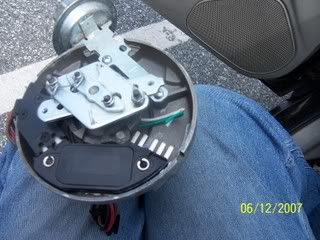





Comment